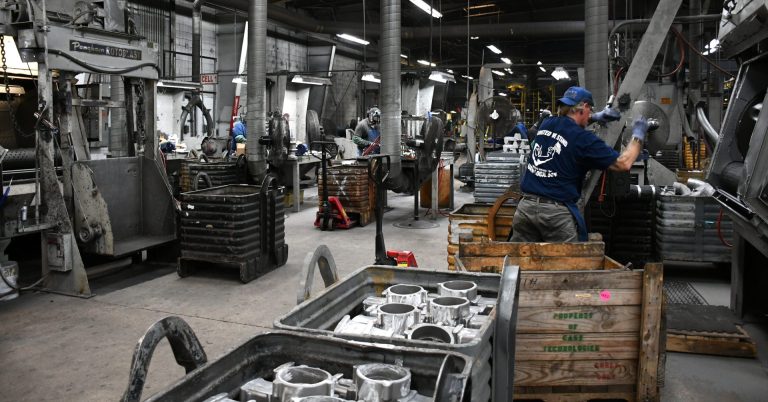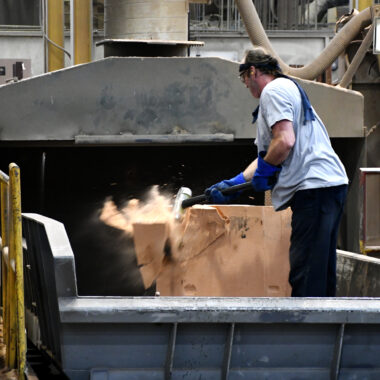Casting Aluminum Illinois: Your Comprehensive How-To Manual
Casting Aluminum Illinois: Your Comprehensive How-To Manual
Blog Article
Precision and Perfection: Ideal Practices for Successful Light Weight Aluminum Spreading
In the realm of aluminum spreading, attaining precision and perfection is not just an objective but a requirement that identifies excellence. The precise procedure of light weight aluminum spreading demands attention to detail at every phase, from product option to final finishing touches. casting aluminum illinois. Each step along the method adds to the ultimate success of the casting process, needing a deep understanding of the interaction in between variables such as mold design, process optimization, high quality control, and completing methods. As we browse via the intricacies of this craft, revealing the most effective practices that lead the way for perfect aluminum castings ends up being a journey worth endeavor.
Product Option
When taking into consideration material selection for aluminum spreading processes, sturdiness, and heat resistance are paramount variables to review,. Aluminum alloys offer a wide variety of choices, each with distinct homes that can considerably impact the top quality and performance of the last casted item. One common selection is the 356 alloy, understood for its excellent fluidness and resistance to rust, making it ideal for a range of applications. For high-stress environments calling for exceptional strength, the 7075 alloy sticks out due to its high strength-to-weight proportion. Furthermore, the 6061 alloy is preferred for its great weldability and formability, making it a versatile option for complex layouts.
In the option process, it is important to take into consideration not just the mechanical residential or commercial properties of the alloy however likewise its thermal features. Heat resistance is important to make sure that the casted component can stand up to the temperature levels it will certainly be revealed to throughout procedure without compromising its structural integrity. By carefully assessing the sturdiness and warm resistance of different aluminum alloys, suppliers can make enlightened choices that cause high-quality, reliable casted products.
Mold And Mildew Layout
In the world of light weight aluminum spreading finest methods, an essential aspect that significantly influences the end product's high quality and stability is the precise design of the mold and mildew. Mold and mildew style plays an important function in identifying the dimensional accuracy, surface area finish, and overall intricacy of the actors light weight aluminum part. When creating a mold and mildew for aluminum casting, numerous crucial elements must be taken into consideration to make sure ideal results.
To start with, the mold design must represent the material circulation qualities of liquified light weight aluminum to stop issues such as shrinking, porosity, or misruns. Proper gating and riser positioning are vital elements in the mold and mildew design procedure to help with smooth steel flow and decrease the formation of air pockets.
In addition, the mold layout ought to take right into consideration the air conditioning rate of the light weight aluminum to avoid fracturing or distortion during solidification. Ample venting and cooling down networks within the mold can aid regulate the temperature level circulation and promote consistent solidification of the steel.
Process Optimization
To enhance efficiency and quality in light weight aluminum casting, procedure optimization plays an essential role in simplifying procedures and optimizing outcome. By fine-tuning each step of the casting process, producers can identify bottlenecks, reduce waste, and enhance overall performance.
In addition, applying lean production concepts can additionally improve process optimization in aluminum spreading. By concentrating and removing non-value-added tasks on constant improvement, manufacturers can attain greater effectiveness levels and far better source usage. Additionally, normal tracking and analysis of key efficiency signs (KPIs) help in recognizing areas for improvement and making data-driven choices to enhance the casting process constantly.
Quality Control
Refine optimization in aluminum spreading not only enhances performance and efficiency yet likewise lays the foundation for rigid quality control actions to maintain industry requirements. Quality control is vital in blog here guaranteeing that last aluminum spreadings meet the called for specifications and efficiency criteria. Carrying out a comprehensive quality assurance process includes numerous steps, beginning with the initial style stage through to the last inspection of the cast components.

In addition, establishing clear quality assurance procedures and documentation treatments is necessary for tracking and checking the casting procedure. By preserving detailed documents of production criteria, testing outcomes, and inspection records, makers can guarantee uniformity and traceability in their aluminum casting procedures. Complying with rigorous quality assurance techniques click to read more not just improves the overall dependability of light weight aluminum castings yet also infuses confidence in clients regarding the high quality of the last products.
Completing Strategies
How can light weight aluminum spreading be enhanced with meticulous application of completing strategies? Finishing techniques play a critical role in raising the top quality and visual appeals of light weight aluminum spreadings. Among the primary techniques utilized is surface area smoothing, which involves the removal of any type of flaws or harsh sides to achieve a flawless surface. This procedure not only improves the aesthetic allure of the spreading but additionally enhances its general capability by ensuring uniformity and precision.

In addition, methods like powder layer or painting can be put on aluminum castings to supply both aesthetic charm and additional protection against ecological factors. By thoroughly picking and applying the suitable ending up techniques, producers can make certain that their aluminum castings satisfy the highest possible standards of quality and performance.
Verdict
In conclusion, successful aluminum casting needs accuracy and excellence in product selection, mold style, process optimization, quality assurance, and ending up strategies. By following best methods in each of these areas, makers can make sure high-quality and consistent lead to their light weight aluminum casting procedures. casting aluminum illinois. It is necessary to focus on every information and continually make every effort for improvement to achieve optimum end results in light weight aluminum spreading
The thorough procedure of light weight aluminum spreading demands interest to detail at every stage, from product option to last completing touches.To improve effectiveness and high quality in aluminum casting, procedure optimization plays a crucial duty in optimizing and enhancing operations output.Refine optimization in light weight aluminum casting view publisher site not only boosts effectiveness and productivity but likewise lays the foundation for stringent top quality control procedures to support industry criteria.One vital element of quality control in light weight aluminum casting is the usage of sophisticated testing strategies to examine the integrity and properties of the spreadings.In conclusion, effective aluminum spreading needs accuracy and excellence in product choice, mold style, process optimization, high quality control, and finishing strategies.
Report this page